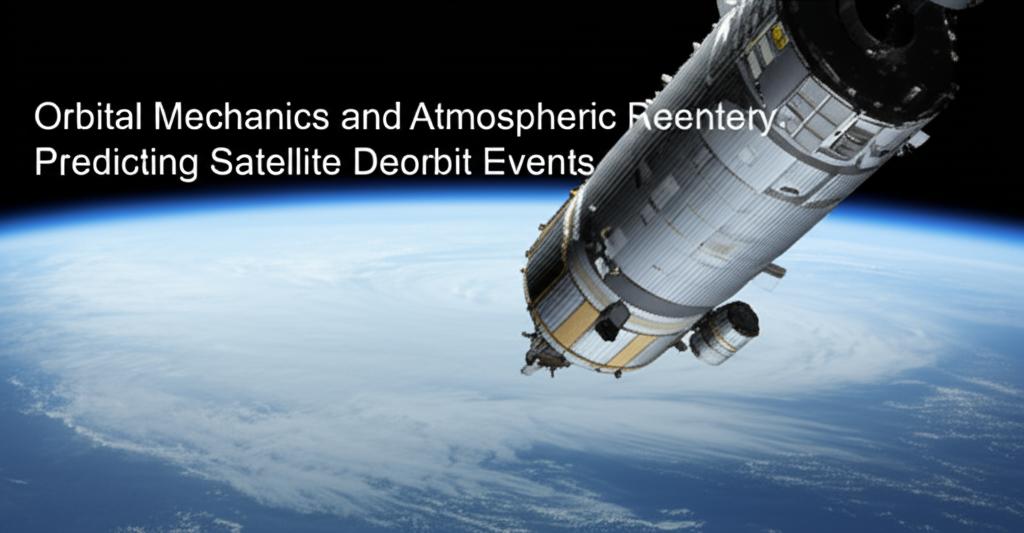Predicting when and where a satellite will deorbit and reenter Earth's atmosphere is a complex but crucial aspect of space operations and safety. This process involves a deep understanding of orbital mechanics, atmospheric science, and the characteristics of the satellite itself.
The deorbit of a satellite is primarily governed by atmospheric drag. While the atmosphere is extremely thin at typical satellite altitudes, it still exerts a frictional force that gradually reduces a satellite's orbital velocity and altitude. This effect is more pronounced for satellites in Low Earth Orbit (LEO), typically below 2,000 kilometers.
Several key factors influence the rate of orbital decay and the subsequent reentry:
- Atmospheric Density: This is the most significant and variable factor. Atmospheric density at orbital altitudes is highly sensitive to solar activity. During periods of high solar activity, such as solar flares and coronal mass ejections, the Earth's upper atmosphere heats up and expands. This expansion increases the density at higher altitudes, leading to greater drag on satellites and accelerating their orbital decay. Conversely, during periods of low solar activity, the atmosphere contracts, reducing drag and extending orbital lifetimes. Predicting solar activity is a major challenge in itself, adding uncertainty to deorbit predictions. The 11-year solar cycle plays a significant role here.
- Satellite Characteristics:
Ballistic Coefficient: This value represents how susceptible a satellite is to atmospheric drag. It is determined by the satellite's mass, cross-sectional area, and drag coefficient. A satellite with a large area-to-mass ratio (like a large solar panel on a small satellite) will experience more drag and deorbit faster than a dense, compact satellite of similar mass. The shape and orientation of the satellite also influence its drag coefficient. Tumbling satellites can present a fluctuating cross-sectional area, making predictions more difficult.
Material Composition: The materials a satellite is made from affect how it will burn up during reentry. Some components, particularly those made of high-melting-point materials like titanium or stainless steel, can survive reentry and reach the Earth's surface.
- Orbital Parameters:
Altitude: Satellites in lower orbits experience significantly higher atmospheric drag and thus decay much faster.
Orbital Inclination: The inclination of the orbit determines the latitudes over which the satellite will pass and potentially reenter.
The Prediction Process:Predicting deorbit events involves several steps:
- Tracking and Observation: Ground-based radar and optical telescopes, as well as space-based surveillance systems, continuously track satellites and space debris. This data provides the current orbital parameters.
- Atmospheric Modeling: Scientists use sophisticated models of the Earth's upper atmosphere to estimate density at various altitudes. These models incorporate solar activity forecasts and other atmospheric data.
- Propagation Software: Specialized software uses the satellite's current orbital data, its ballistic coefficient, and atmospheric model predictions to propagate its trajectory forward in time, estimating the decay rate and predicting the reentry window.
- Atmospheric Variability: Accurately forecasting atmospheric density remains a significant hurdle due to the unpredictable nature of solar activity and its effects on the thermosphere.
- Uncertainty in Satellite Properties: For uncontrolled deorbits, especially of older satellites or debris, the exact shape, orientation, and material composition might not be well known, leading to uncertainties in the ballistic coefficient.
- Fragmentation Events: If a satellite breaks up during reentry, predicting the trajectory and impact points of individual fragments becomes exponentially more complex.
- Computational Demands: Precise long-term predictions require significant computational resources.
With the increasing number of satellites and space debris, accurate deorbit prediction is more critical than ever. It is essential for:
- Space Situational Awareness (SSA): Knowing when and where objects will reenter helps maintain a clear picture of the space environment.
- Risk Assessment: Predicting potential impact zones allows for warnings to be issued to air traffic and populated areas, though the risk of harm to individuals is extremely low.
- Debris Mitigation: Understanding natural decay helps in planning active debris removal missions and in designing satellites for controlled reentry or demise.
Research continues to focus on improving atmospheric models, refining techniques for estimating satellite characteristics through remote observation, and incorporating machine learning for better prediction accuracy. International collaboration in sharing tracking data and research findings is also vital for enhancing global capabilities in predicting satellite deorbit events. The aim is to reduce the uncertainty windows for reentry, which can currently range from hours to days in the lead-up to the event.

